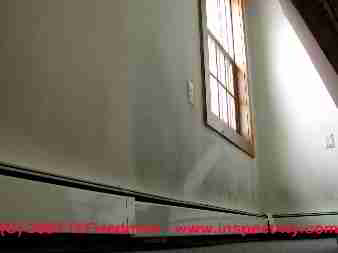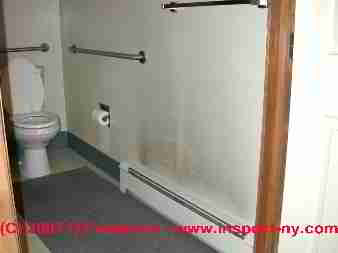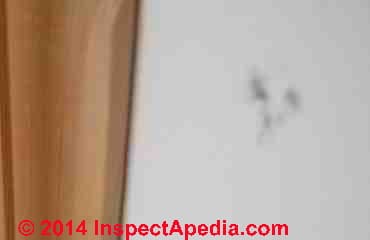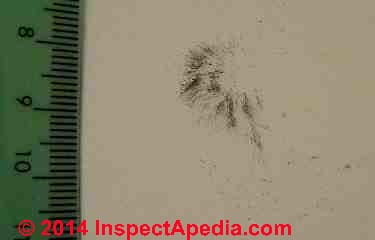 Wall Stains & Thermal Tracking
Wall Stains & Thermal Tracking
How to Recognize & Diagnose Stains on Building Walls
- POST a QUESTION or COMMENT about relating thermal tracking ghosting marks indoors to building insulation defects, air leaks, heat loss, and heating bills.
Diagnose & fix stains on building interior walls.
This article describes the role of air leaks and soot deposition in indoor stains - clues that can sometimes explain high building heasting costs. Thermal tracking or ghosting stains may indicate insulation voids, air leaks, high indoor moisture, as well as serving as a collection point for airborne dust, dirt, soot, or other debris.
This article describes how to recognize & diagnose thermal tracking and other dark or sooty stains on building interior walls and discusses other various interior wall and ceiling stains and explains how to recognize thermal tracking, thermal bridging stains, building air leaks, and building insulation defects.
Often these stains are mistaken for toxic indoor mold. When investigating a building for a mold problem, you can save mold test costs by learning how to recognize stuff that is not mold but may be mistaken for more serious contamination.
InspectAPedia tolerates no conflicts of interest. We have no relationship with advertisers, products, or services discussed at this website.
- Daniel Friedman, Publisher/Editor/Author - See WHO ARE WE?
How Air Leaks Cause Thermal Tracking or "Ghosting" Stains on Building Walls & Ceilings
The black marks or stains or "sooting" observed in a characteristic pattern on building walls or ceilings are comprised of substances that cause black sooty marks on building interior ceilings or walls and sometimes also on carpets are from sources and causes that you can easily learn to recognize in buildings.
Indoor air contains dust particles, whether you see them directly or not.
As this air passes over building surfaces, where a surface area is cooler than surrounding materials, these particles are usually deposited at a higher rate (due to higher moisture on the cooler surface).
Thermal tracking stains may appear on the building walls themselves, in a pattern of vertical "stripes" which may be roughly 16" or 24" on center, marking the (cooler) location of wall studs or ceiling joists.
In this case the exterior wall surface (see that window at right in the photo) are cooler where the wall studs are located and warmer between the wall studs. Probably the wall cavity is insulated, and the insulated areas have a higher "R" value than the solid wood studs themselves.
So the wall is cooler where the studs are located, increasing condensation on those surface areas, and picking up a greater share of house dust in air moving across those surfaces.
Thermal tracking stains may appear as dark black/brown wall stains appearing close to floor level, above heating baseboards mounted on exterior walls are probably due to thermal tracking.
Wall Stains over Heat Sources such as Hot Water Baseboards
Heaters can cause other dirt or soot stains on walls: But beware, a baseboard heater itself causes an air convection current up through the heating baseboards and in a dirty home or in a home occupied by pets or smokers similar stains may appear on other building interior walls (such as in this photograph) even if the wall is well insulated.
If staining appears vertical and at intervals thermal tracking is probably occurring.
The stain and soot deposition pattern over heaters is complicated by variations in the heat and air movement coming out of the heat source, and may not always accurately map wall stud or insulation locations.
More wall stains from heat sources such as over an air supply register in a floor are described
at OTHER STAINSon Indoor Walls & Ceilings and ceiling stains from heating or air conditioning registers are described
at STAINS HVAC SUPPLY REGISTERS
Why Black Stains May Appear on Building Interior Walls as Well as on Building Exterior Walls
Our photo at below left shows wide black rectangular stains on a wall where insulation was omitted. The photo at below right shows long narrow black stains on a wall where thermal tracking marked the location of wall studs, but where insulation was present. Why did both of these patterns appear in the same building?
High interior moisture (air handlers in wet crawl spaces, a wet basement) was most likely the determining factor in the extent of staining that occurred in this home. Moisture condensed (and caused adhesion of house dust particles) on cooler surfaces.
In some areas the un-insulated wall was coolest and got stained (below left) while in other areas the wall studs were cooler than the insulated wall cavity, so the stud-areas got stained (below right).
Black, roughly rectangular stains on building interior or exterior walls: may be present wherever insulation has been omitted.
While usually these stains are going to appear on the building exterior walls (which get colder) they may appear on interior walls as well. These stains on interior walls, which may be completely un insulated, may appear with greater severity where other construction details increase the flow of air and/or moisture in certain sections of wall cavity.
An example of the cause of this stain pattern is air movement up through the wall cavity from a cool, damp basement or crawl space.
The heated building living space warms the open interior wall cavity, causing air in that cavity to rise by natural convection towards the building attic or roof cavity.
Air movement upwards in the wall cavity draws cooler air from the basement or crawl space. Where some wall sections have more air movement, less insulation, or greater moisture exposure, they may become more darkly stained than their neighbors or more darkly stained than other walls in the building interior.
Usually soot marks, thermal bridging, or thermal tracking stains appear, if at all, in the building interior locations discussed in the remaining sections of this article.
Black or Dark Spots on Walls: diagnose accurately before "fixing" or cleaning
Black spots on walls may be ghosting, thermal tracking, leak stains, or even metallic debris - wire wool "mold" !
Here are the photos before I identified the cause.
They are sharp of the woodwork, but not as good as I'd like of the marks. I realise I should have used something with more definition like a ruler.
If you'd like me to have another go then let me know. I can see that in less prominent situations, the wire wool could easily rust over time, leading to mysterious rust marks being discovered much later. - P.W. 7/8/2014
Reply:
I've had the same camera focus trouble. If you can find a thin flat metal ruler to place alongside a mark and then try again for a sharp photo that would be more useful, but I'll also go ahead and post these. Can we say something about just where in the home these marks appeared? for example are they only close to woodwork that was scrubbed with steel wool pads?
And how was paint applied later: by roller? I'm presuming this was a latex paint and that's why (reaction of the particles to moisture in the paint) we see the material telegraphing through the coating.
If you're curious & thus if you decide to try to capture some of the actual material on adhesive tape you can mail that to me and I'll examine & photograph the material microscopically.
See details at DUST / MOLD TEST KIT INSTRUCTIONS
For other readers diagnosing black spots or stains on interior walls, because pets lying against walls can also leave black smudge marks, also
see PET STAINS & MARKS in BUILDINGS
Reader follow-up:
I managed to get some clearer photos of the wire wool strands magnetically attached to the hidden nail heads - there was a setting on the camera that I didn't know about to focus close up. Here they are.
Yes, thinking about where they are, all of the marks were either within 12 inches to the side, or below where some wire wool preparation had been done. I don't think any was above.
The painting had already been done (brush and roller). I was varnishing after the completed painting, so the particles stuck (presumably through magnetism) to a completely smooth and dry surface.
The bonding was also very weak and the fibres very light - holding the tip of a screwdriver two inches away was enough to make all the particles come through the air and attach to the screwdriver.
My understanding is that nails don't have any innate magetic force associated with them, but banging them into a surface can make them magnetic.
Reply:
Indeed you're correct. Koch (2000) specifically states that hammering can cause molecular movement in metals and induce magnetism.
Induced magnetic effects of hammering on or striking nails, steel, or other metallic objects
- Hargraves, R. B., and W. E. Perkins. "Investigations of the effect of shock on natural remanent magnetism." Journal of Geophysical Research 74, no. 10 (1969): 2576-2589.
- Hughes, D. E. "The cause of evident magnetism in iron, steel, and other magnetic metals." Journal of The Franklin Institute 116, no. 2 (1883): 128-150.
- Koch, Dallas, and Cindy Barden. Discover! Magnetism & Electricity (eBook). Lorenz Educational Press, 2000.
- Pumfrey, Stephen. "Mechanizing magnetism in restoration England—the decline of magnetic philosophy." Annals of science 44, no. 1 (1987): 1-21.
Am I correct that you could simply wipe away these particles as they landed after the paint was dry?
Reader follow-up: metallic particles adhered to drywall nails simply wipe away
That's very interesting. It seems the opposite of what we were taught at school i.e. if a magnet gets too many knocks then it will lose its magnetism.
You are right about wiping away the particles. If the surface underneath is dry, then they can be wiped off with a dry cloth.
Magnetic Drywall Screws Explain Wall Spots of Metallic Fragments
Here's one final postscript.
Last weekend I met the man who had put up the walls and discussed this with him. He explained that he hadn't, in fact, used nails to put up the walls: it appears that everyone around here now uses screw guns to attach plasterboard to a frame, as it's considerably faster than nails (and screws can be unscrewed to correct errors, or course).
The screws come in magazines and are manufactured magnetic to that they remain attached to the screwdriver bit while being positioned on the wall. That explains why the wire strands formed around every single screw, not just the odd one or two,
Of course that makes the idea of magnetising nails less relevant, but I think it raises a more interesting question.
These screws will not lose their magnetism just because they are driven into the wall, so all modern houses (round here, anyway) will now have a magnetic field around every place where the plasterboard is attached to the wall. Over time, I wonder what will happen as a result of that.
Lessons learned about diagnosing indoor black spots on walls or ceilings
Knowing the answers to these questions can help diagnos black spot stains indoors:
- When did the stain appear? In the case above the stains appeared after final painting and after re-finishing of woodwork using steel pads for wood surface cleanup
- What other building work or events or changes have been going on?
- Where are the stains located relative to other building features? In the case above the black spots appeared only close to and relatively parallel to woodwork and the stains appeared only where metal drywall nails had been used. The stains were located in a pattern matching the location and interval of drywall nails.
- In what rooms are the stains present? In the case discussed above the black spot stains appeared only where re-finishing work had progressed.
- Can we wipe off the stain easily leaving a clean surface? If so the deposit happened after finish work such as painting on that surface and is probably not related to a bleed-through or rust problem.
...
Continue reading at THERMAL TRACKING BRIDGING GHOSTING or select a topic from the closely-related articles below, or see the complete ARTICLE INDEX.
Or see WALL STAIN DIAGNOSTIC FAQs - questions & answers posted originally at this page.
Or see these
Recommended Articles
- AIR MOVEMENT in BUILDINGS - When, where, how & why air moves in buildings.
- CEILING STAIN DIAGNOSIS
- HEAT LOSS in BUILDINGS
- MOLD APPEARANCE - STUFF THAT IS NOT MOLD
- STAINS on INDOOR SURFACES, PHOTO GUIDE
- THERMAL TRACKING BRIDGING GHOSTING - home
- DEFINITION of THERMAL TRACKING
- EIGHT INTERACTING FACTORS CAUSE GHOSTING
- AIR VELOCITY & MOVEMENT PATTERNS
- COMPOSITION of DARK GHOSTING STAIN PARTICLES
- GHOSTING STAIN INSPECTION
- GHOSTING DARK STREAKS or LINES: CAUSES
- GHOSTING DARK RECTANGULAR STAINS: CAUSES
- GHOSTING DARK STAINS from AIR LEAKS
- GHOSTING DARK STAINS on INSULATION, AIR BYPASS LEAKS
- GHOSTING STAINS on WALLS
- STAINS CANDLES FIREPLACE WOODSTOVE
- STAINS DIAGNOSE IAQ PROBLEMS
- STAINS INDICATE SAFETY CONCERNS
- STAINS MISTAKEN for GHOSTING
- THERMAL TRACKING REMEDIES
Suggested citation for this web page
WALL STAIN DIAGNOSIS at InspectApedia.com - online encyclopedia of building & environmental inspection, testing, diagnosis, repair, & problem prevention advice.
Or see this
INDEX to RELATED ARTICLES: ARTICLE INDEX to BUILDING STAINS
Or use the SEARCH BOX found below to Ask a Question or Search InspectApedia
Ask a Question or Search InspectApedia
Try the search box just below, or if you prefer, post a question or comment in the Comments box below and we will respond promptly.
Search the InspectApedia website
Note: appearance of your Comment below may be delayed: if your comment contains an image, photograph, web link, or text that looks to the software as if it might be a web link, your posting will appear after it has been approved by a moderator. Apologies for the delay.
Only one image can be added per comment but you can post as many comments, and therefore images, as you like.
You will not receive a notification when a response to your question has been posted.
Please bookmark this page to make it easy for you to check back for our response.
IF above you see "Comment Form is loading comments..." then COMMENT BOX - countable.ca / bawkbox.com IS NOT WORKING.
In any case you are welcome to send an email directly to us at InspectApedia.com at editor@inspectApedia.com
We'll reply to you directly. Please help us help you by noting, in your email, the URL of the InspectApedia page where you wanted to comment.
Citations & References
In addition to any citations in the article above, a full list is available on request.
- In addition to citations & references found in this article, see the research citations given at the end of the related articles found at our suggested
CONTINUE READING or RECOMMENDED ARTICLES.
- Carson, Dunlop & Associates Ltd., 120 Carlton Street Suite 407, Toronto ON M5A 4K2. Tel: (416) 964-9415 1-800-268-7070 Email: info@carsondunlop.com. Alan Carson is a past president of ASHI, the American Society of Home Inspectors.
Thanks to Alan Carson and Bob Dunlop, for permission for InspectAPedia to use text excerpts from The HOME REFERENCE BOOK - the Encyclopedia of Homes and to use illustrations from The ILLUSTRATED HOME .
Carson Dunlop Associates provides extensive home inspection education and report writing material. In gratitude we provide links to tsome Carson Dunlop Associates products and services.






